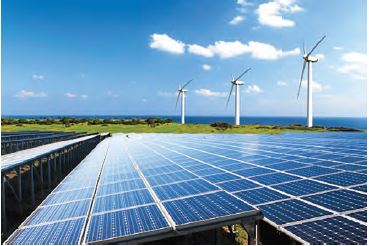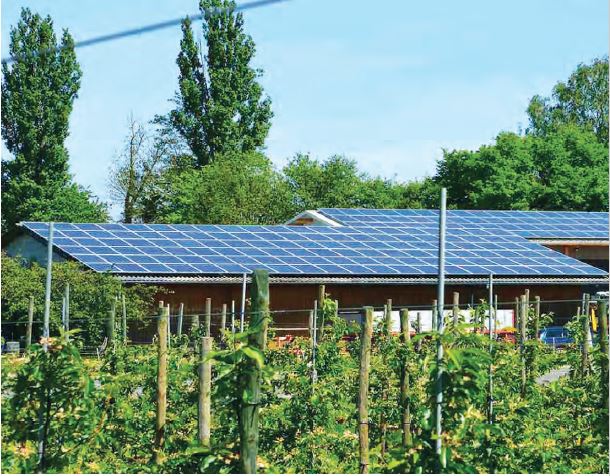 |
|
 |
WEB EXCLUSIVES |
 |
|
| |
| |
 |
| Cover Story
|
 |
 |
| Textiles’ – the word brings up images of beautiful drapes – cotton, silk, chiffon, lace. Whether it is the material draped on the figurine of the lady... |
|
 |
| |
read more... |
 |
|
 |

|
|
Tapping Sustainable Energy Alternatives
|
|
|
The second lead article, which is also focus article, is written by Shri N Bhadran Nair. Citing a report of the World Health Organisation, the author has advocated for tapping sustainable energy alternatives
|

|

|

|

|
|
Financing Renewables in India
|
|
|
The third article is written by Shri P C Maithani, Adviser, Ministry of New and Renewable Energy. He has focussed on renewable energy resources
|

|

|

|
|
Steps to Achieve India’s Solar Potential
|
|
|
The special article is written by Sumant Sinha, Chairman and Managing Director of ReNew Power. He opines that India must also honour its global commitments on curbing greenhouse gas emissions
|

|

|
|
|
 |
|
|
|
|
| |
Goods and Service Tax-The ‘flawless’ paradigm and thereafter
Dr. Debdulal
Thakur
GST in a nutshell
The voters must be informed voters, and not all read economics. Therefore, from a citizen’s perspective it is important to understand about such critical public policies. It is well understood by all, that the 122nd Constitutional Amendment Bill is certainly the most sought after subject in Indian economy- at least as of date.? ..
Nonetheless, before moving further, it is important to understand the basic differences between GST and VAT. According to Mukhopadhyay (2014), GST can be seen as a VAT including service tax. However, strictly speaking, if service tax is excluded, it is only VAT. Added to this, for private sector or corporates, the turnover tax with a clear credit of input tax is synonymous to a VAT. Therefore, GST can be seen as a reformed VAT regime including service tax. It is important to understand at this juncture that VAT is not a progressive tax, rather it is a proportional tax wherein the same tax rate is applied across all irrespective of the income class of the taxpayers. Naturally, it has nothing to do with social justice or redistributive objectives. Having said so, it is also true that, post GST implementation there will be a single, comprehensive value-added tax on both goods and services which will be levied at every stage of a formal transaction. Since, GST will be levied only on the value added during a particular stage of production so the burden of taxation will be shifted to the final consumer. Not to worry about the magnitude of the burden because, the final consumer need not bear much heat as the taxes paid at earlier stages will be set off. Also, it will minimize the complexity that aroused due to multiplicity of taxes, broaden the tax base for indirect taxes and thus is expected to make tax evasion less attractive.
Calculating ‘flawless’ GST- the ‘as is analysis’
Now, to calculate the efficiency of a VAT regime, economists calculate the VAT revenue ratio (VRR) which is simply the ratio of actual revenues collection vis-à-vis the expected revenue assuming a single rate and full compliance. So, from a purely revenue perspective a VRR close to unity would be preferable then otherwise. Taking all these into consideration, the report submitted to the 13th Finance Commission by the task force on GST proposed a ‘flawless’ GST. In this they clearly mentioned that since there are ample issues with VRR, the task force actually expanded scope of final consumption given the constraints imposed by the National Accounts to compute the potential tax base. As per the recommendation of the said tax force , whole objective of a GST as a resource mobilizing handle, would only be successful if and only, the policy deficiencies could be removed. As per their estimates, even then a VRR would be around 0.76. According to this report one of the main deterrents to low realization was the extent of exemptions which was around 0.64 in the pool of potential tax base and thus reducing the actual collectable tax base to 0.36. One can easily, gauge about the actual collections from this meager pool of collectables. To simplify, out of every hundred rupees of potential tax baseRs.64 would be lost due to exemptions and the residue of Rupees 36 is the amount of collectable tax- so the actual collection with all possibilities would be even lower and thus hamper the revenue pool..
Added to this, to keep parity between the Central GST and the State GST a revenue neutral rate (RNR) was also proposed by this task force, using 2007-08 as the base fiscal year. The sole objective of this RNR was to ensure that the new GST regime should not end up simply as another discretionary measure for additional resource mobilization. To cross check the validity of these numbers five standard independent methods (Subtraction-Indirect Method, Consumption Method-Task Force Estimate, Consumption Method-NCAER Estimate, Shome Index Method and Revenue Method) were used and quite surprisingly, the estimates calculated by the task force were quite close to the estimates of Poddar and Bagchi (2007). Theoretically and to some extent using estimated numbers it can be said for sure that yes it is possible through GST to strengthen and give a positive scale shift in the exchequer. However, this can only be possible through a strong tax administration, compliance and with reduced exemptions.
The Ground Reality
The real picture emerges
exactly from the above argument. Can all our state governments contribute or are
able to adhere to the above restrictions (strong tax administration, compliance
and with reduced exemptions) posed? A close look and an elementary athematic
using data published by the Reserve Bank of India for 2012-13 (accounts) shows
that the average contribution of revenue in the form of taxes in the pool of the
16 non- special category states (excluding the newly formed Telengana) taken
together comes around 7.14 percent (ofcourse one may treat Maharashtra and Uttar
Pradesh as outliers as they contribute the most in this pool). Surprisingly,
states like Bihar, Chhattisgarh, Goa, Haryana, Jharkhand, Kerala, Madhya
Pradesh, Odisha, Punjab, Rajasthan and West Bengal are positioned at the tail of
the curve with contribution significantly low then the average of all these 16
states. After recalculating the figures removing the two outliers only improves
the situation marginally. This essentially indicates that there seems to be
something really wrong- somewhere very deep with the policy makers elected by
us. Therefore, the issue is far more serious compared to what has been cautioned
by the task force. It is high time for the states to realize the immense
potential of GST and built or replenishes the infrastructure for a better tax
administration and boosts the prospect and thereby realizes the collectable
taxes, at least. On the other hand they should also realize that simply populist
politics won’t be helpful to sustain the bourgeoning expenditure burden despite all
prudent checks and balances.
Better India? Yes. But…
Agreed, that the new
regime would not only help ensure vertical equity, but is expected to restore
horizontal equity as well. Also, as proposed, the Centre should provide a 100
percent compensation for the revenue loss to the state governments. But, going
by the logic of the task force, there should also be counter clause as what if
the state governments due to typical populist politics stars the game of
exemptions or they deviate on their own from the GST base or rate which are
collectively agreed upon? It is not simply the beginning of another regime or
about petty benefits, rather accepting the fact that post 1991 it would be the
biggest and most challenging tax reform in India (Ofcourse for a better
tomorrow)- a strong political consensus is must. After all, their voice is
supposed to be the echo of ours- and we all are in favour for a better India.
References:
Government of India (2009): Report of the Task Force on Goods and Service Tax,
Thirteenth Finance Commission, Government of India, 2009.
Mukhopadhyay, Sukumar (2014): Clearing the cobwebs from the concept of GST,
Business Standard, November 9, 2014
Poddar, Satya and Amaresh Bagchi (2007): Revenue-neutral rate for GST, The
Economic Times, November 15, 2007.
NCAER (2009): Moving to Goods and Services Tax in India: Impact on India’s
Growth and International Trade, Thirteenth Finance Commission, Government of
India.
The author is Assistant Professor, Department of Economics, BITS-Pilani (K.K.
Birla Goa Campus)
Email:
debdulalthakur@gmail.com
Dial: 91-9158311248
Webpage: http://universe.bits-pilani.ac.in/goa/debdulal/profile
|
|
|
|
|
|
|
|
|
|
 |

|
Regional Languages
|
 |
|
|
 |
|
Regular
Column |
|
J&K Window : |
|
|
|
Do you know? : What is Forensic Auditing |
|
Forensic auditing refers to the auditing with the main aim to employ accounting techniques and methods to gather evidence to investigate the crimes on financial front such as theft, fraud etc.
|
|
|
 |
|
 |
 |